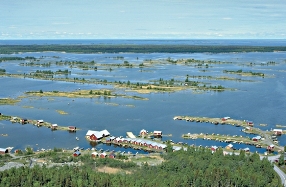The Kvarken Archipelago
The Kvarken Archipelago numbers 5,600 islands and islets. The area covers a total of 194,400 ha of which 15 % is land and 85 % is sea. The Kvarken world heritage features unusual ridged washboard moraines, De Geer moraines, formed by the melting of the continental ice sheet, 10,000 to 24,000 years ago.
The Archipelago is continuously rising from the sea in a process of rapid glacio-isostatic uplift. The land, previously weighed down under the weight of a glacier, lifts at a rate of about 8 mm/year. This rate is among the highest in the world.
The nature of the Kvarken Archipelago is special - and the geomorphology, i.e. the moraine ridges, is extraordinary. The flat archipelago of Kvarken, and the steep High Coast in Sweden together constitute a complete example on how the land uplift forms the landscape and influences biological processes.
In 2006 UNESCO's World Heritage Committee added the Kvarken Archipelago to the World Heritage List as an extension to the World Heritage site of the High Coast. The Korsholm archipelago is a part of the Kvarken archipelago. The Kvarken archipelago is the first nature World Heritage of Finland.
|
|
||||
|
Start
|
 |
|
Björköby, Svedjehamn. De Geer-moraines. Photo: Arto Hämäläinen, Mustasaaren kunta©
The High Coast/The Kvarken Archipelago. Picture: Kvarken.fi |
|
Read more about the Kvarken Archipelago: Unesco.org Kvarken.fi |






